
Hindley is a town within the Metropolitan Borough of Wigan in Greater Manchester, England. It is three miles (4.8 km) east of Wigan and covers an area of 2,580 acres (1,044 ha). Within the boundaries of the historic county of Lancashire, Hindley borders the towns and villages of Ince-in-Makerfield, Aspull, Westhoughton, Atherton and Westleigh in the former borough of Leigh. In 2001, Hindley had a population of 23,457, increasing to 28,000 at the 2011 Census. It forms part of the wider Greater Manchester Urban Area.

St Ann's Church is a Church of England parish church in Manchester, England. Although named after St Anne, it also pays tribute to the patron of the church, Ann, Lady Bland. St Ann's Church is a Grade I listed building.

Little Lever is a village in the Metropolitan Borough of Bolton, Greater Manchester, England. Within the Historic County of Lancashire, it is 2 miles (3.2 km) southeast of Bolton, 2 miles (3.2 km) west of Radcliffe and 4 miles (6.4 km) southwest of Bury. In the 19th century, the population was employed in cotton mills, paper mills, bleach works, terracotta works, a rope works and numerous collieries.

Deansgate is a railway station in Manchester city centre, England, 1,100 yards (1 km) west of Manchester Piccadilly, close to Castlefield at the junction of Deansgate and Whitworth Street West. It is part of the Manchester station group.
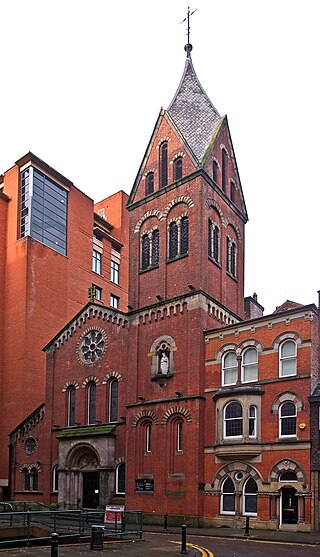
The Hidden Gem, officially St Mary's Catholic Church, is a church on Mulberry Street, Manchester, England. The parish dates back to 1794, with devotion to St Mary, Our Lady of the Assumption. The present church, rebuilt in 1848, is a Grade II*-listed building which includes the Diocesan Shrine of Our Lady of Manchester.

The architecture of Manchester demonstrates a rich variety of architectural styles. The city is a product of the Industrial Revolution and is known as the first modern, industrial city. Manchester is noted for its warehouses, railway viaducts, cotton mills and canals – remnants of its past when the city produced and traded goods. Manchester has minimal Georgian or medieval architecture to speak of and consequently has a vast array of 19th and early 20th-century architecture styles; examples include Palazzo, Neo-Gothic, Venetian Gothic, Edwardian baroque, Art Nouveau, Art Deco and the Neo-Classical.
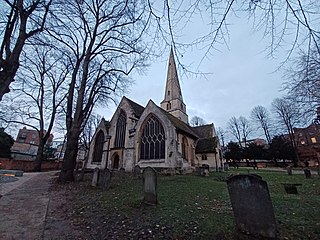
Cheltenham Minster is the minster and parish church of Cheltenham in Gloucestershire, England.
Walter Carroll was an English composer, music lecturer and author. He was born at 156 Great Ducie Street in the Cheetham district of Manchester.

St Matthew's Church is in St Matthew's Street, Burnley, Lancashire, England. It is an active Anglican parish church in the diocese of Blackburn. The original church was built between 1876 and 1879, and was designed by William Waddington and Sons. This burnt down in 1927 and was replaced by the present church. In the 1970s St Matthew's joined with the neighbouring Holy Trinity Church.
Edwin Hugh Shellard was an English architect who practised in Manchester, being active between 1844 and 1864. Most of his works are located in Northwest England, in what is now Greater Manchester, Lancashire, Cheshire, and Derbyshire. He was mainly an ecclesiastical architect, and gained contracts to design at least 13 churches for the Church Building Commission, these churches being known as Commissioners' churches. Most of his designs were in Gothic Revival style, usually Early English or Decorated, but he also experimented in the Perpendicular style. He employed the Romanesque Revival style in his additions to St Mary's Church, Preston. The National Heritage List for England shows that at least 23 of his new churches are designated as listed buildings, four of them at Grade II*. The authors of the Buildings of England series consider that his finest work is St John's Minster in Preston, Lancashire.
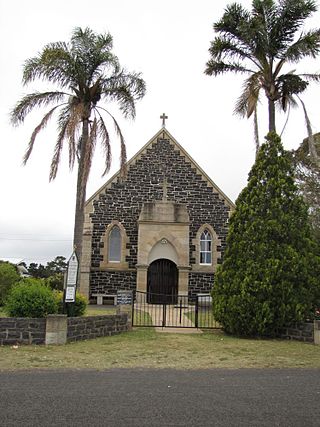
St Matthew's Anglican Church is a heritage-listed church at Beatrice Street, Drayton, once a town but now a suburb of Toowoomba in Toowoomba Region, Queensland, Australia. It was designed by James Marks and built from 1886 to 1887 by Seath, Hobart and Watson. It is also known as St Matthew's Church of England and is the second church of that name in Drayton. It was added to the Queensland Heritage Register on 21 October 1992.

Sir James Farmer was an English manufacturer and the mayor of the County Borough of Salford, England, for two terms between 1885 and 1887.

St John's Gardens in central Manchester, England, lies between Lower Byrom Street, Byrom Street and Quay Street. Previously occupied by St John's Church and its graveyard between 1769 and 1931, the site was redeveloped into a formal garden in 1932. It contains a central memorial to the church and those buried in its graveyard, whose tombstones have been covered over by 18 inches (460 mm) of soil except for that of John Owens, founder of Owen's College.
St Matthew's Church, Campfield, was an Anglican parish church in Manchester, England, that was designed in 1822-25 by the architect Charles Barry in a Gothic style. Built on Liverpool Road, it was a Commissioners' church and was demolished in 1951–52. The associated Sunday school building survives and has been converted into offices known as Gunn House.
John Clowes was an English cleric and Fellow of Trinity College, Cambridge. Despite his position in the Anglican church, for which he served as Rector of St John's Church, Manchester from 1769 until 1831, he was a noted disciple of Emanuel Swedenborg and did much to propagate his ideas in the Manchester area.
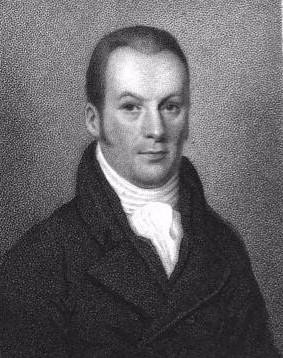
William Roby (1766–1830) was an English Congregational minister.
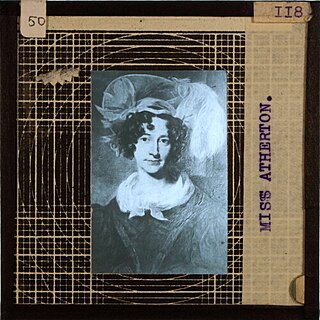
Eleanora Atherton was an English philanthropist best known for her work in Manchester, England. At the time of her death, she was one of the richest British women in the nineteenth century.
Manchester is a city in Northwest England. The M3 postcode area of the city includes the western part of the city centre. The area contains 79 listed buildings that are recorded in the National Heritage List for England. Of these, five are listed at Grade I, the highest of the three grades, two are at Grade II*, the middle grade, and the others are at Grade II, the lowest grade.

George Woodhouse was an English architect who practised from offices in Bolton, and Oldham, then in the county of Lancashire. He collaborated with William Hill on the designs for Bolton Town Hall.

St John Street is a street in central Manchester, England. It consists mainly of late Georgian and Regency era terraced houses. Laid out between 1770 and 1830, the street runs roughly east–west between Deansgate and Byrom Street, terminating in an urban park, formerly the site of St John's Church, at its eastern end. Originally built for the prosperous Manchester upper-middle classes, by the 20th century it had become the preserve of the medical and legal professions. In the 21st century, some of the buildings are being reconverted to residential use. The only surviving Georgian terraced street in central Manchester, many of its buildings are listed.
















